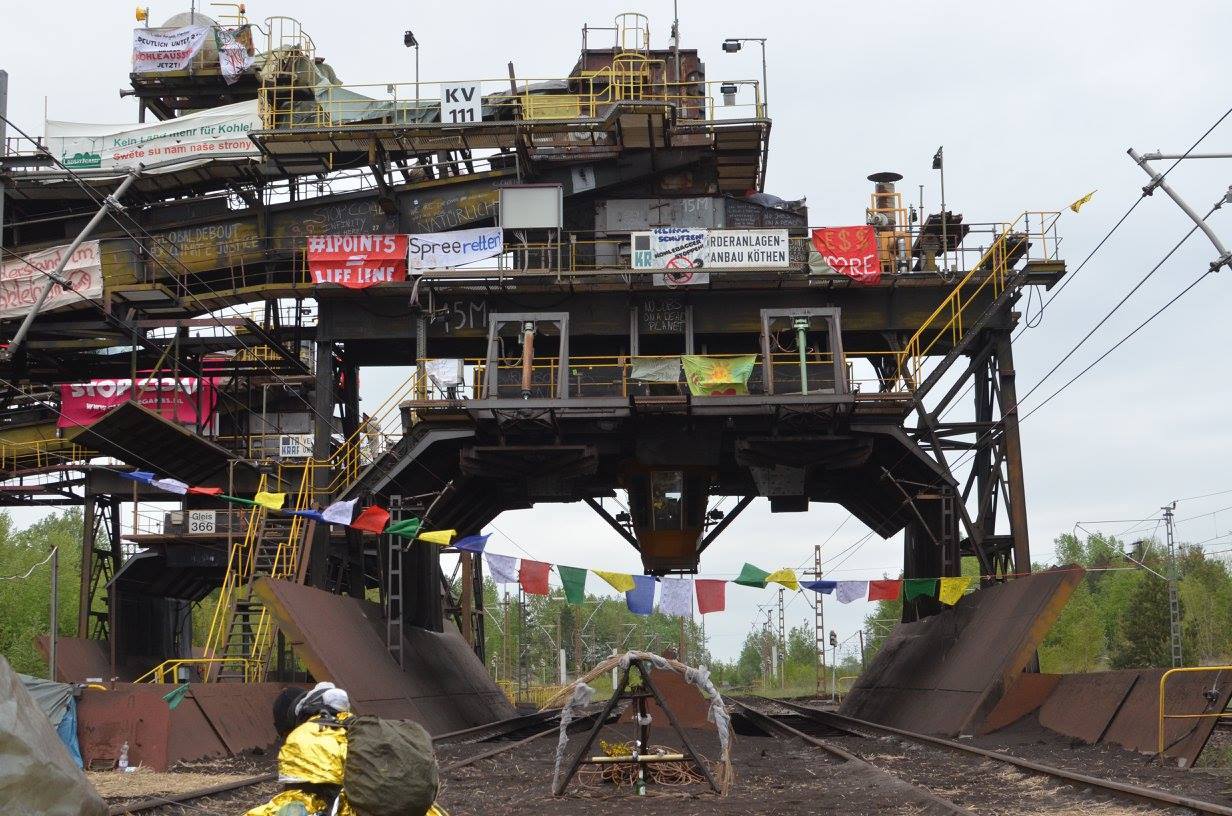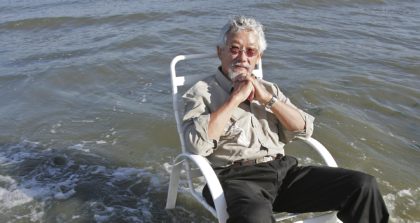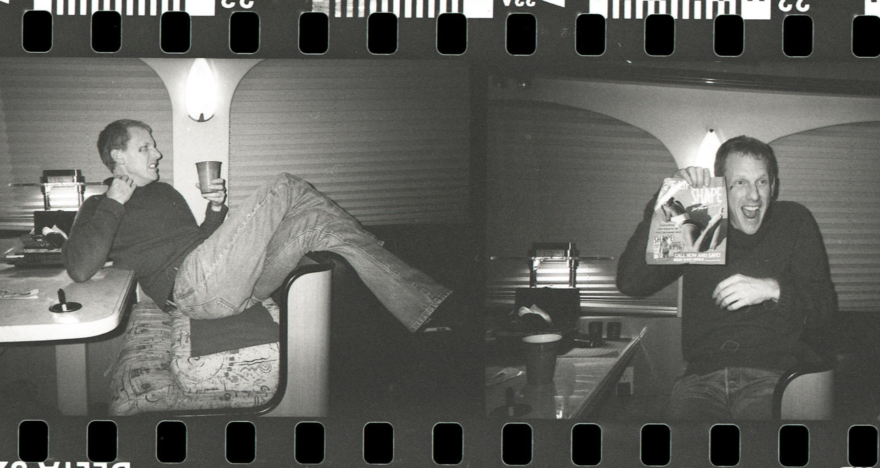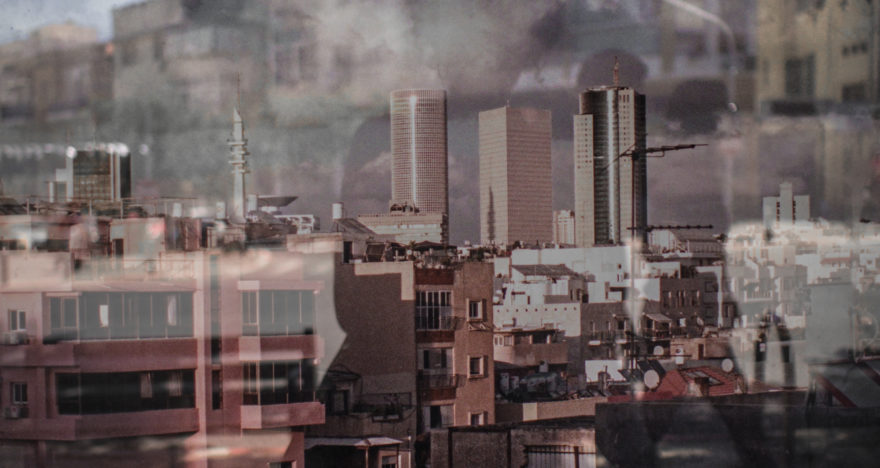The New Ecological Situationists: On the Revolutionary Aesthetics of Climate Justice and Degrowth

“Woah, look at all the layers!” We were on hands and knees, carefully examining lumps of coal, placing them in a little bag to bring home and show to friends later. There it was, the stuff that has powered nations for almost two centuries. The brittle rock that charges our phones and laptops. The substance that helps to keep our economic system and modern lives going. We had never seen it before, and in its presence, we were reduced to children collecting shells on the beach.
We were in UK’s largest open-cast coal mine in Merthyr Tydfil, Wales. As part of a global week of actions against coal, about 150 of us had gathered to occupy a coal mine, to express our dissent against the continued extraction of fossil fuels—which, we now know, is the primary contributor to global warming and is already helping our world plummet into climate-induced chaos. Our intent was to block the functioning of the mine for one day, signaling our dissent against an economy that relies so heavily on fossil fuels.
And, despite our very serious goals, we were having fun. Someone blasted reggaeton from a small speaker, amplifying it in the arm of a digger. People had brought along over-sized inflatable grey cubes, which we then played volleyball with as we danced. When I asked someone about them, I was told they were meant to look like cobblestones, a reference to the French activist slogan, “under the cobblestones, the beach” (sous les pavés, la plage). What did it mean?
Flash back to the year 1968
In a single year, protests erupted across the world: Czechoslavakia, Mexico, Pakistan, Poland, United States, Italy, Spain, and France. It felt like a worldwide revolution. In Paris, students and workers gathered on the streets to protest against capitalism, consumerism, and American Imperialism. This led to a two-week general strike, bringing the whole country’s economy to halt and even leading President Charles de Gaulle to flee the country.
The atmosphere was, by all accounts, ebullient. People were literally taking apart the streets: ripping out cobblestones, erecting barricades, coming out in public in large crowds—it felt like anything was possible. The slogan, “under the cobblestones, the beach”, referred to the practice of tearing out cobblestones to erect barriers against the police. In the act of protest, people were reshaping their own city, discovering what could possible be beneath it, uncovered through the act of rebellion.
That sense of play was influenced by a movement called “The Situationists”. The Situationist International was a collective of artists, thinkers, poets, and activists who wrote tracts discussing philosophy, capitalism, and aesthetics. Many of their aphorisms made their way on the walls of Parisian streets in May ’68, as graffiti or posters:
Politics is in the streets.
No replastering, the structure is rotten.
Action must not be a reaction, but a creation.
Art is dead, let’s liberate our everyday life.
Barricades close the streets but open the way.
Be realistic, demand the impossible.
The Situationists were known for developing certain games that would help people rethink their place in society and their surroundings. For example, the dérive (drift) is a practice where a small group travels through the city for hours on end without a particular goal, letting themselves be pulled by the contours of the terrain, the flow of urban space. These games were tools to explore the city and reconfigure it.
This sense of play fit well in the uproar of ’68. The protests that erupted all around the world were, in some way, dérives en masse: people realizing, together, the power they had to take over the streets and wander them endlessly.
We used the railroads as beds
Today, the sense of global awakening may not be as frenetic as it was then. But we do face crises that are much more pressing. The financial crash of 2008, the rapid advent of climate change, and extremist racism in response to immigration and the influx of refugees displaced by war—all of these reflect a general crisis that are today shaking the foundations of decades of stability.
It is this feeling of urgency that leads people to occupy coal mines and pipelines. And, like the work of the Situationists of the 1960s, these actions are often playful, aesthetic experiences.
For the past three years, activists from all Europe have gathered at a massive lignite coal mine in the Rhine region in Germany. The message is simple: Ende Gelände means “here and no further.” The action starts with a large camp, which is organized in different sections that are democratically run through a spokes-council structure. Then, over three thousand people march to the Welzow-Süd open-cast coal mine and camp there for two days.
From all accounts, it’s breathtaking. “It wasn’t my first mass protest, but it was spectacular,” says Sixtine van Outryve, a Belgian climate activist who occupied the mine in 2016. “We got past the police, and then we arrived at these railroads, where we set up camp. We used the railroads as beds. It became a camp with yoga and art classes, we built shelters for the rain. We climbed on this huge structure that transfers the coal from the train to the plant and made it ours. I ate coal, I breathed coal, I sweated coal, for two days. We looked different. It felt alien for sure. Everything was transformed. It felt ours for a little time, we could live there.”
Matthias Schmelzer, a German academic and activist, also considered the occupation of Ende Gelände to be transformative. “It’s so vast, and embodies the destruction of our economic system to our environment. The experience of going into the mine, and seeing these huge machines—some of the largest machines ever built—the scenery is really impressive.”
For van Outryve, actions like Ende Gelände are often playful. “We always have a principle of ‘Alegria militante’ [militant happiness]. Without making it playful, you don’t make it livable. If you’re making it too serious, then you’re like the professional politicians. Making it playful is deprofessionalizing it, making it part of everyday life.”
Schmelzer, similarly, noted the play present in the actions. “People bring plants and plant them in the coal mines. There’s a lot of laughing. People really have a good time.” Schmelzer added dryly after a pause, “Some get hit by the police, and they don’t have a good time.”
The Situationists planned dérives to play around in, and better understand, urban space. And aren’t coal mines part of urban space? Coal has shaped our cities and powered global urbanization. So, the coal mine is an excellent site for a dérive.
Economy jamming
Though actions like these can be fun, their goals are practical: to register dissent against the fossil fuel industry, and encourage leaders to invest in renewables. And yet, even if they succeed in shutting down a coal mine or power plant for a day or two, organizers acknowledge that it’s mostly a symbolic action.
Selj Balamir, a designer and organiser for the Climate Games and Fossil Free Culture Netherlands, has thought a lot about the messaging behind these actions. “We need to make something that’s impossible to look away from, create something with a visual impact. Ultimately, what is a mass action if not the greatest form of land art?” Balamir describes another action, Code Rood 2017, targeting Europe’s second largest coal harbor in Amsterdam. “You enter it with 300 people, and you are on another planet. The power of those images is to drag people’s attention to say, ‘look what’s happening in your clean, bike-friendly city.’ It creates an impact that numbers or petitions don’t.”
In doing so, organizers of these festivals of dissent are inspired by the activist practice, popular in the 1990’s, of “culture jamming”. Best represented by Adbusters magazine, the idea is to use advertising, slogans, and imagery of the dominant consumerist culture against itself. For example, “subvertisers” will deface billboards with their own message—one that looks strikingly real but tells a more critical story. This could be as simple as replacing “KFC” with the more astute “FCK”. Really makes you think, right?
Subvertisers and culture jammers also take a page from the Situationists, who used the term “détournement” (rerouting, hijacking) to describe the practice of re-using popular images and phrases as a tool of counter-cultural propaganda. With a slogan like “we are the investment risk!” Ende Gelände inverts the language of speculative capital with a knowing wink.
This kind of performativity isn’t just for the media, it was felt at the actions as well. Angela Drummond (name changed) attended her first climate camp in 2008, at Kingsnorth coal-fired Power Station in Kent. The goal was to shut down the station for a day. At the time, environmental protest camps were seen as a significant threat by the UK police. So Drummond found herself in what felt like a war zone: helicopters overhead, 4 a.m. police raids, violent arrests, stop-and-search pens. It became a bit of a dance between the protestors and police: “I sort of think that the whole thing was strangely performative: if the police wanted to enter, they could have done so.” For Drummond, the sense of being besieged “made engaging with the camp seem like the most imperative thing. Even though in many ways the camp was a horrible place to be, it was also one of my fondest memories, because it generated a sense of meaningful united action.”
The action Drummond participated in was, from its very conception, an absurdity. “My first encounter with climate activism was watching a short promotional video. It said something like ‘Kingsnorth Power Station. We will shut it down.’ It was really exhilarating, and I thought, this looks like fun. The whole camp was about shutting it down. There was a lot of performance and pretense. No one actually knew how to shut down a power station. It just became a myth that there was a big red button, we’d have to search for it, and just hit it. In the handbook, there was a drawing of the big red button: ‘this is what you need to press.’ That was literally the plan. Unsurprisingly, we didn’t get into the power station, and no one managed to find the big red button. It was an action built on a joke.”
Yet, despite their close affiliations, these ecological warriors seem to go much further than the culture jammers. Balamir explicitly draws a distinction between the two: “Culture jamming was a response to the extreme sophistication of marketing that popped up in the ’90s. It largely failed, with the exception of Occupy Wall Street. It made me realize that either we see these tactics in small scale and only occasionally succeed in disrupting anything, or we have to try to scale up our ambitions. Low-key propaganda is one thing, but our goals are of creating a political crisis on climate.” We could, instead, call it “economy jamming”.
High-level trolling
In 1972, André Gorz used the term décroissance to describe the need for a total material reduction of resource use, if we want to maximize wellbeing. A prominent French philosopher in the 1960s, Gorz had been deeply affected by the events of 1968, realizing that desire and aesthetics often drive social movements, and that the state and highly bureaucratic unions were ill-equipped to address alienation at the core of society and the mounting ecological problems of his day.
In the early 2000s, a small group of French intellectuals like Serge Latouche revived the word décroissance and turned it into a movement slogan. Since then, there have been organized six international Degrowth conferences with thousands of attendees.
From the start, the word was intended as a provocation, a response to the unexamined assumption that economic growth is always good, and that global sustainable development must follow the same model around the world. Paul Aries called it a “missile word” and a “political weapon”; Latouche called it a “symbolic challenge”, a subversive term with the intention to make people pause and question taken-for-granted assumptions.
Not a fan of militaristic metaphors, I prefer to think of degrowth as high-level trolling. The word tends to send pundits and economists into a frenzy, leading to spend more time trying to debunk it than trying to understand it. For example, Paul Krugman, a celebrity economist with a column in the New York Times, spent two whole columns attempting to discredit it. Branko Milanović, a development economist, entered into a debate with degrowth advocate Jason Hickel, and, throwing up his hands, proclaimed, “I do not think that this program is illogical. It is just so enormous, outside of anything that we normally can expect to implement, that it verges, I am afraid, on absurdity… If put to test in real life, rather than at conferences and blogs, Jason’s program would receive support from almost no one.”
Aside from the criticism from economists, others, like the post-growth economist Kate Raworth and blogger Brian Dean, have argued that the term itself is unfortunate. According to cognitive science, all it does is reactivate the concept of growth in people’s minds, just making them hold on to it more.
These criticisms are legitimate, but lose sight of the original intent of the word. In response to the article by Brian Dean, the Research & Degrowth network (of which I am a member), tweeted that it is “a provocative slogan and should not be interpreted literally”; a “a serious and subversive slogan: an act of détournement!” Once again, it seems that environmentalists have inherited the tactics of the Situationists.
This shared tradition came to life in Ende Gelände in 2016 and 2017, which hosted a degrowth summer school with up to 500 attendees a week before the occupation of the coal mine. For Matthias Schmelzer, who helped to organize the degrowth summer school and has written an article on the links between degrowth and climate justice movements, the two were complimentary. “The pollination went in both ways. There was a lot of inspiration for the degrowth people to move into action. And in reverse, degrowth highlighted some of the issues that are already in the climate justice framework, but not so developed, like how to do a just transition in rich countries, or how to organize the economy [beyond fossil fuels].”
Though Schmelzer writes extensively on degrowth, he is mixed on its effectiveness. “For some people who basically share the core arguments, degrowth is an entry into thinking about systemic alternatives. This is working very well. But for other people, I’m not so sure. It’s making it much easier for opponents to be against degrowth, and for not really engaging with the argument, and just dismissing it off-hand.”
Schmelzer’s hope is that degrowth could at least provoke people to change their perspective, so that, if more progressive movements do come to power, they won’t be as interested in the same kinds of industrialization. “At least within the radical left, and some parts of the broader left, it’s not so easy to just promote growth anymore. It needs to be justified more than before.” As a “missile concept”, it seems to have landed, at least in certain circles.
The mythos of rebellion
In many ways, the climate justice movement has fought a symbolic battle. Their actions are not just practical occupations of extractive sites, intended to put a stop to business-as-usual, but they are also aesthetic practices.
Samuel Alexander, a professor at the University of Melbourne in Australia, has recently come out with a book, Art against Empire: Toward an Aesthetics of Degrowth. In its introductory essay, he argues that aesthetic experiences can help convince people on the need to change our economic system. Art, he writes, has “the potential to provoke social change via different mechanisms of persuasion, making emotional, psychological, or even spiritual impacts on an audience at those times when science, logic, and argument have failed. The artist can conjure up new modes of perception, providing a feast of sensuous experience that anticipates, often explosively, a different way of living and being in the world.”
For van Outryve, aesthetics had a role both within movements and to outsiders. “Marching in the streets, just having the demands without anything else, it’s just burning people out. You don’t make any community around that. The creation of an aesthetic joins people in a more creative act. From the outside, people are more receptive to messages that are conveyed through art.”
Since the development of corporate mass media, we have become a global society obsessed with spectacles. As people grow more and more isolated from each other, we are nevertheless bombarded with a constant barrage of images, which we can’t possibly ignore. This situation puts activists in a double bind: in order to bring people together, they have to participate in the spectacle. Every action becomes a performance, competing for precious media time.
For Samuel Alexander, politics is always a form of narration. “…[P]olitics and economics are tools in the service of story. Crafting these stories is an aesthetic process of giving form to the content of our lives and societies, akin to a collaborative work of art.”
Balamir seems to agree with this. “We are telling stories. The power of those stories is that they shape—maybe too slowly—what is possible. Now we need to find ways to jam, to hack, cultural formations. Aesthetics and storytelling go hand-in-hand.”
The new ecological situationists are busy refining these tools, trying to capture the spirit of the present and illuminate a path forward. Their actions, spectacles themselves, are aimed to pierce into the spectacle of our lives. The question is, however, whether this is enough. As Schmelzer notes, “In the end, good ideas by themselves have never changed anything. To change something, there’s always a struggle, with different interests opposing each other.”
How can the stories we tell shape the struggle to come? Schmelzer’s provocation makes me wonder, when we are once again swept up in simultaneous protests around the world, what slogans will we spray paint on the walls? How will these slogans inform new visions of the future?
Aaron Vansintjan is a co-editor of Uneven Earth and editor of the book, In defense of degrowth.
He tweets at @a_vansi about cities, food, politics, and science fiction.







View Comments
No Comments (Hide)